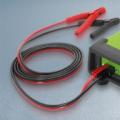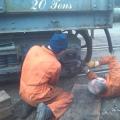In the cold season, the road surface is usually very irregular: ice, a rolled track or a snowy "mess" can suddenly appear on the asphalt. This feature significantly affects driving safety.
Changing the driving style
First of all, you need to realize: as soon as a trailer appears, the car behaves differently: braking distances increases, and much more room for maneuver is required. And if you are accustomed to fast acceleration and sharp braking, then with a trailer you will have to forget about this practice, otherwise it will bring you in. The speed must be reduced by 20 km / h from what is usual for you in a particular situation. If, for example, there is a 90 km / h limit on the highway, then you should drive with a trailer no faster than 70 km / h. By the way, common reason accidents on a snowy or icy track is that car owners do not install winter tires on the trailer. We strongly recommend "changing shoes": in this case, the trailer will add much less.
Braking wisely
The biggest danger on the road in winter is ice. On ice, the wheels do not have sufficient grip. road surface, therefore, the machine may suddenly become uncontrollable. Abrupt braking on slippery road in winter, almost 100% guarantees the occurrence of a skid. And if the trailer does not have its own brakes, then this further aggravates the situation: it pushes rear axle vehicle, causing the entire road train to rotate. Happiness if at this moment the oncoming lane is empty! But even this does not guarantee that the accident can be avoided: the trailer itself "folded" can hit your car in the side. Therefore, the driver's task is to avoid sudden braking by any means. It is necessary to prepare in advance for maneuvers and reduce speed in dangerous areas. If the car is not equipped with ABS, you need to brake with short and frequent pedal presses to avoid blocking the wheels. And the most the best way- engine braking, that is, a sequential downshift.
Avoiding swaying
The driver of the road train needs to monitor not only the behavior of the vehicle, but also of the trailer. We felt lateral vibrations - the trailer began to swing like a pendulum - add gas to "stretch" the road train and avoid a rhythmic skid. The same should be done if the trailer starts to throw out of the rut - pressing the gas will extinguish the "bumpiness".
More accurate with the curbs
On country roads, you need to be especially careful. A high snow "curb" is often formed on the side of the road, which can cause a car with a trailer to skid and dump into a ditch. In order not to catch this "curb", you need to move slowly, and if it is necessary to part with the oncoming car, additionally reduce the speed. Overtake only when full confidence that do not drive into the oncoming shoulder.
Deep snow
Another attack on country roads in winter - deep snow... If you have an all-wheel drive SUV, shift to a lower gear. On front wheel drive drive in first gear and avoid wheel slip. If you get stuck, you need to clear the snow in front of the wheels and try to get out of the swing, moving the car back and forth. If it does not help, you will have to unload the trailer, getting rid of excess ballast.
Tips for safe driving prepared by specialists of the "Expedition Trailers" direction of the Krasnokamsk Mechanical Repair Plant
How to properly operate light trailer in winter, so as not to get into accidents and not pose a threat to other road users? What are the nuances of driving you should be aware of in order to prevent situations such as a trailer skidding or overturning into a ditch?
Winter tires
Every year, on the eve of a long winter period, issues related to the need to change tires on cars are discussed at all forums of motorists. There are substantial discussions about whether it is necessary to change the shoes of the trailer to studded tires. As a rule, the opinions of the drivers do not coincide.
Some car owners are sure that it is necessary to change tires for both the tractor and the trailer. Others disagree, in their opinion, if you accelerate and brake calmly, then winter tires a trailer is optional. There are also those drivers who prefer to put the so-called "all-season" on light trailers in winter or ride on studless winter tires.
In winter, the road can be slippery, another danger is loose snow, drifts on the roadside. The driver must be able to react correctly and quickly if he sees in the mirrors how the trailer is skidding. Moreover, there are dangers from all sides. If a left turn, the trailer pulls over to the curb, gets bogged down in loose snow and pulls the car behind him. On the right corner, a trailed platform with summer tires generally flies into the oncoming lane if an inexperienced driver is driving.
Avoid hard braking
The biggest threat of skidding for a trailer is ice on the road, when the grip of the wheels is not enough, the road train can become uncontrollable. On an icy road, do not slow down sharply. The trailer, not equipped with its own brakes, pushes the tractor, which causes both vehicles to spin. In addition, the road train may collapse, and the trailed platform will hit the tractor sideways. To avoid this, the driver must prepare for all maneuvers in advance, brake with the engine, consistently shifting to a low gear.
Prevent the trailer from swinging
If lateral vibrations occur, measures must be taken to stop the wobbling of the trailer. To do this, the driver must accelerate smoothly, stretching the road train and preventing rhythmic skidding. In the event that the trailer starts to jump out of the rut, you should also increase the gas, the "bumpiness" will stop.
Loose snow and drifts
To drive out of deep snow onto all-wheel drive include low gear. If the car is front-wheel drive, put the first gear, make sure that the wheels do not start to slip. If your road train is stuck in deep snow, it should be removed at least in front of the front pair of wheels and, moving forward and backward, try to get out. If this method does not work, all that remains is to unload the trailer.
In our specialized workshop, you can always get advice on how to drive a machine with a trailer in winter period... Call us!
Such an addition to a passenger car as a trailer significantly expands the capabilities of the car itself, and for many car owners it is often simply necessary.
As a rule, for these purposes, that is cars, single-axle trailers are used.
Single axle trailers
Such trailers, depending on their established maximum mass, are usually divided into "light" ones, for which the permitted maximum weight established by the manufacturer does not exceed 750 kg, and "heavy" trailers, with the permitted maximum mass exceeding 750 kg.
Single axle trailer
These types of trailers differ not only in their "carrying capacity". Unlike "heavy" trailers, "light" trailers are not always equipped, while "heavy" trailers must be brakes on a mandatory basis.
What should be equipped with a car
In order for the car to be able to drive with a trailer, it must be equipped with a standard type with a plug socket through which the trailer's electrical circuit is connected to the vehicle's electrical circuit.

Trailer coupling
Also, if the trailer is wider than the towing vehicle and thereby impairs the rear view for the driver, the car must be equipped with rear-view mirrors with extended brackets.
When going on the road with a trailer, you should always have two wheel chocks in the car, which are placed under the wheels if the car stops on a slope.
Rules for driving with a trailer
Driving a car with a trailer has its own characteristics:

1. You should always take into account that the trailer significantly changes the "behavior" of the car on the road, and its presence requires special attention from the driver. When driving with a trailer, the braking distance of the road train will necessarily increase, and the dynamics and acceleration time will also decrease, even if the trailer is empty.
In this case, the cross-country ability of the vehicle and its maneuverability, on the contrary, deteriorate. These factors force you to drive the road train at a low speed, avoiding sudden acceleration and braking.
2. When performing various maneuvers, it is always necessary to take into account the length of the road train, its large dimensions, and the so-called "turn corridor" created by the road train, that is, the trajectory along which the car and the trailer move in the turn.
Performing such maneuvers as, for example, overtaking or braking when driving with a trailer, you need to have a sufficient margin of distance and time, and take into account that the dynamic characteristics of the car have become worse.
3. Get under way when towing a trailer as smoothly as possible, without jerking. Otherwise, the wheels can start to slip, which leads to intensive tire wear, increases fuel consumption, and can cause damage to the transmission or hitch.
4. Obstacles encountered on the road or other vehicles you need to go around, making a larger than usual interval, and also, to return to your lane after making a detour, it is necessary at a greater than usual distance from these objects.
5. Such a maneuver as overtaking is quite dangerous, therefore, it should be performed only if it is really necessary, and it must be borne in mind that the overtaking area has become larger, due to a decrease in the dynamics of the car.
6. We must not forget that a car with a trailer is characterized by a tendency to "fold", that is, "run over" of the trailer on the car, which can cause a skid.
Typically, this effect occurs during braking, especially when cornering. To avoid such a nuisance, you need to reduce the speed in advance before turning. If it was still not possible to avoid "folding", the road train can be leveled by stopping the braking and increasing the speed.
7. When driving with a trailer on unpaved roads, try not to drive between tracks, as the trailer can get into one track, and the car itself into another.
8. Having no experience in driving a car with a trailer, it is advisable to practice on a safe platform for movement reverse- it is such a maneuver that often causes difficulties.
9. The correct placement of the load on the trailer also needs to be given special attention. Most the best option"Weight distribution" of the trailer is considered such that its drawbar will be supported by the hitch with a force from 35 to 95 kg.

Correct and incorrect placement of cargo on the trailer
If the load is not placed correctly, that is, when the weight is shifted forward or backward relative to the trailer axle, the load on the coupling device increases significantly, which can lead to poor vehicle handling.
During long trip you need to make stops from time to time, and check the reliability of fastening the load in the trailer.
10. Going on the road with a trailer, every time you need to check the reliability of the towing device, the serviceability of the light signaling, bring the car and the trailer back to normal, check their condition, check the reliability of the wheels, the correct position of the load in the trailer.
Video - driving with a trailer around the city:
Hope this article answered all your questions. Good luck on the road!
Driving on the roads of our country requires constant attention and caution from drivers, regardless of the season. However, in winter, when ice builds up on the roads and huge amounts of snow appear on the roadside, driving becomes even more extreme. This is especially true for those who continue to operate their car with a trailer in winter.
So, everyone knows that the grip of the wheels on the road covered with ice or rolled snow is very poor and it is necessary to keep an increased distance from the vehicle in front. When driving with a trailer, you need to keep this distance even more, since a loaded trailer significantly increases your stopping distance. Braking should always be very smooth (preferably with the engine), since any hard pressing brakes will cause side skid. If it is necessary to execute emergency braking, then do it by short impulse depressions on the brake pedal. If you plan to use your trailer frequently in winter, it is better if it is equipped with a braking system.
When cornering, try to slow down as much as possible and enter in the most gentle trajectory. Pressing the gas pedal must also be done smoothly. Any mistake on a slippery road will inevitably provoke a skid.
When driving on narrow and country roads, pay close attention to the shoulders. A large amount of snow accumulates on the sides of such roads, which can cause the trailer to skid and be pulled into a ditch, and this is very dangerous. The higher the speed of your road train, the more difficult it is to avoid pulling, therefore, when driving with oncoming vehicles on narrow roads, try to slow down. Overtake on such roads only if you are completely sure that the shoulder oncoming lane has a hard surface.
It is necessary to be especially attentive to the roads covered with freshly fallen snow. Many people think that the grip on these roads is better, but this is not at all the case. Usually under this snow there are icy areas and fresh snow when braking or cornering will only increase the skid.
If you are caught in deep snow, then you need to move slowly on low gear and make sure that there is no wheel slip. Try not to stop or make sharp turns. If your road train does get stuck in the snow, try swinging or just use a shovel to clear the road in front of the wheels.




